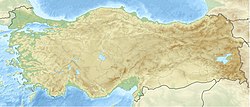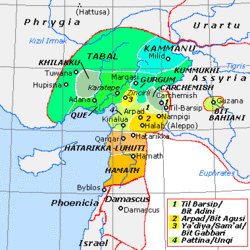Top Qs
Timeline
Chat
Perspective
Cybistra
Town of ancient Cappadocia From Wikipedia, the free encyclopedia
Remove ads
Cybistra or Kybistra, earlier known as Ḫubišna,[1] was a town of ancient Cappadocia or Cilicia.
The main city of Kybistra/Ḫubišna was located at the site corresponding to present-day Karahöyük,[2] about 10 km northeast of the modern town of Ereğli in Konya Province, Turkey.[3][4][5][6][7]
It was the capital of a Luwian-speaking Neo-Hittite kingdom in the 1st millennium BCE.
Remove ads
Name
The name of the city was recorded during the Old Assyrian Colony Period as Ḫabušna (Old Assyrian Akkadian: 𒄷𒁉𒅖𒈾).[8]
The name of the city was Ḫūpišna (𒌷𒄷𒌋𒁉𒅖𒈾,[9] 𒌷𒄷𒁉𒅖𒈾,[9] 𒌷𒄷𒁉𒌍𒈾,[9] 𒌷𒄷𒄫𒈾[9]) or Ḫapušna (𒌷𒄩𒁍𒍑𒈾[10]) during the Hittite Empire.[8][1]
The city appears in Neo-Assyrian records under the names:[1]
During Classical Antiquity, the city became known as Cybistra (Ancient Greek: Κύβιστρα, romanized: Kúbistra; Latin: Cybistra).[8][1]
Remove ads
History
Summarize
Perspective

Bronze Age
Middle Bronze
Prior to the Hittite period, Ḫūpišna was a strategic hub guarding the northern end of the Cilician Gates going south to Tarsus.[citation needed]
According to the Telepinu Proclamation, Ḫūpišna was one of the places which the 17th century BCE founder-king of the Hittite Old Kingdom, Labarna I had conquered and over which he had subsequently appointed his sons as rulers.[2]
During the 16th century BCE, the late Hittite Old Kingdom king Ammuna carried out several military campaigns to attempt to re-subjugate former states which had revolted against Hittite suzerainty, including Ḫūpišna.[2]
Late Bronze
Ḫūpišna was mentioned in the texts of the Hittite Empire, as a country located in southern Anatolia, in the part of the Lower Land corresponding to the later Classical Tyanitis.[1]
Iron Age
Kingdom of Ḫubišna
After the collapse of the Hittite Empire, Ḫubišna became one of the Neo-Hittite states of the region of Tabal, in whose southern regions it was located.[1][2]
Little is known about the kingdom of Ḫubišna. The king Puḫame of Ḫubišna did not initially submit to the Neo-Assyrian king Shalmaneser III (r. 859 – 824 BCE) after 24 other kings of the Tabalian region submitted to him following his attack on the kingdom of Tabal proper during his campaign there in 837 or 836 BCE. Puḫame became a tributary of Shalmaneser III only after he passed through the kingdom and capital of Ḫubišna.[15]
By c. 738 BC, the Tabalian region, including Ḫubišna, had become a tributary of the Neo-Assyrian Empire, either after the Neo-Assyrian king Tiglath-pileser III's (r. 745 – 727 BCE) conquest of Arpad over the course of 743 to 740 BC caused the states of the Tabalian region to submit to him, or possibly as a result of a campaign of Tiglath-pileser III in Tabal.[16][17][6]
Therefore, the king Uirimmi of Ḫubišna was mentioned in the records of the Neo-Assyrian Empire as one of five kings who offered tribute to Tiglath-Pileser III in 738 and 737 BCE.[1][18][2]
In 679 BCE, the Assyrian king Esarhaddon (r. 681 – 669 BCE) defeated the Cimmerians and killed their king Teušpa at Ḫubišna. Esarhaddon appears to have reached Ḫubišna by passing through the Göksu river valley and bypassing the Anti-Taurus Mountains and Tabal proper.[19]
List of rulers
- ᵐPuḫame (Neo-Assyrian Akkadian: 𒁹𒁍𒄩𒈨[20][21][22]), r. c. 837 BCE
- ᵐUirimmi (Neo-Assyrian Akkadian: 𒁹𒌑𒄿𒊑𒈪[23][24]), r. c. 740 BCE
Classical antiquity
Strabo, after mentioning Tyana, says "that not far from it are Castabala and Cybistra, forts which are still nearer to the mountain," by which he means Taurus.[25] Cybistra and Castabala were in that division of Cappadocia which was called Cilicia. Strabo makes it six days' journey from Mazaca to the Pylae Ciliciae, through Tyana, which is about half way; then he makes it 300 stadia, or about two days' journey, from Tyana to Cybistra, which leaves about a day's journey from Cybistra to the Pylae. William Martin Leake observed, "We learn also from the Table that Cybistra was on the road from Tyana to Mazaca, and sixty-four Roman miles from the former." Ptolemy places Cybistra in Cataonia.[26]
When Cicero was proconsul of Cilicia (51/50 BCE), he led his troops southwards towards the Taurus through that part of Cappadocia which borders on Cilicia, and he encamped "on the verge of Cappadocia, not far from Taurus, at a town Cybistra, in order to defend Cilicia, and at the same time hold Cappadocia.[27] Cicero stayed five days at Cybistra, and on hearing that the Parthians were a long way off that entrance into Cappadocia, and were hanging on the borders of Cilicia, he immediately marched into Cilicia through the Pylae of the Taurus, and came to Tarsus.[28] This is quite consistent with Strabo.
Remove ads
Bishopric
Cybistra was from an early stage a Christian bishopric, as shown by the participation of its bishop Timotheus in the First Council of Nicaea in 325. Cyrus took part in the Council of Chalcedon in 351 and was a signatory of the letter that the bishops of the Roman province of Cappadocia Secunda, to which Cybistra belonged, sent in 458 to Byzantine Emperor Leo I the Thracian after the murder of Proterius of Alexandria. The diocese no longer appears in Notitiae Episcopatuum from the end of the 15th century.[29][30]
No longer a residential bishopric, Cybistra is today listed by the Catholic Church as a titular see.[31]
List of titular bishops
- Nicasio Balisa y Melero, O.A.R. (14 January 1941 to 3 February 1965)
- Jacques-Antoine-Claude-Marie Boudinet (11 March 1856 to 16 June 1856)
- Philippe François Zéphirin Guillemin, M.E.P. (8 August 1856 to 5 April 1886)
- Eduard Herrmann (Hermann) (30 August 1901 to 3 March 1916)
- Johannes Baptist Katschthaler (4 June 1891 to 17 December 1900)
- Paul Nègre (7 December 1916 to 7 February 1940)
- Alexander Paterson (14 May 1816 to 30 October 1831)
- Martin Poell, O.F.M. (20 June 1890 to 2 January 1891)
References
Sources
Wikiwand - on
Seamless Wikipedia browsing. On steroids.
Remove ads


